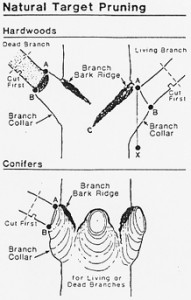A Guide to Correct Pruning
Correct pruning is the best thing you can do for your trees and shrubs. Here are some useful guidelines:
Natural Target Pruning
Removing a limb
- Locate the branch bark ridge (BBR)
- Find target A – outside BBR
- Find target B – where branch meets collar
- If B cannot be found, drop an imaginary line at AX. Angle XAC equals XAB.
- Stub cut the branch
- Make final cut at line AB (with power saws make final cut on upstroke).
Do Not:
- Make flush cuts behind the BBR
- Leave living or dead stubs
- Injure or remove the branch collar
- Paint cuts
Wound Dressing
Wound dressing should be considered only cosmetic. Research shows that they do not stop decay. Do not interfere with the natural process. Maintain the tree’s health and it will take care of the wounds.
PRUNING – When?
- When dormant
- When sap flow is slow (i.e. bleeders)
- Spring blooming plants – after flowering
- Late flowering plants – on same years wood – before new growth
- Evergreens – pinch new growth (New growth will only occur from green tissue!)
- Hedges – as required to maintain size and shape
PRUNING – Why?
- Improve and maintain health
- Improve flowering and fruiting
- Remove dead, diseased, broken wood
- Remove crossing or rubbing branches
- Control natural shape and size
- Prune for safety
- Prune for visibility
- Provide for sun and air circulation
- Restore balance
- Rejuvenate deciduous shrubs
PRUNING – How?
- Use clean sharp tools.
PRUNING – Do’s and Don’t s
- Never give haircuts
- Never leave stubs
- Never use dull equipment
- Never prune everything to one shape
- Always plan every cut
- Prune to an outward facing bud
- Stand back and look
PRUNING – Types of Cuts
- Pinching back
- Heading back
- Shearing
- Thin out
- Drop crotch
- Jump cut
- Rejuvenate
- Directional cuts
- Pollarding

